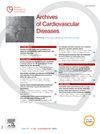长读RNA测序在心肌病中的应用:一种具有强大潜力的基因诊断新方法?
IF 2.3
3区 医学
Q2 CARDIAC & CARDIOVASCULAR SYSTEMS
引用次数: 0
摘要
扩张型心肌病(DCM)是一种遗传性疾病,其遗传诊断条件为患者随访和家庭护理(主要基因TTN)。然而,目前基于DNA短读(SR DNA- seq)的测序诊断率仅为15-25%,这表明了方法的局限性。RNA长读(LR-RNA-Seq)方法可以缓解这种不足,因为它可以检测难以捉摸的DNA重排和隐性异常剪接致病突变,这是提高诊断率的一种有吸引力的策略。目的评价全转录组LR-RNA-Seq检测编码外显子单核苷酸变异(SNVs)和短/复杂DNA结构变异(SV)的可行性。方法选取26例可用心脏RNA(移植心脏)的DCM病例。cDNA文库制备完成后,在PromethION24 (ONT)上进行LR-RNA-Seq测序。使用LR专用的生物信息学工具(Clair3)来命名snv和SV。真正的变异呼叫阈值是通过使用相同样本的DNA桑格测序来推断的。结果样本共覆盖116m reads(±6.9 M),其中85%为长(>;400 pb),因此用于校准。我们对90%的读数进行了比对,这些读数的平均大小为1094 pb(±80)。在Clair3质量评分的扩展范围内选择的33个假定的LR-RNA-Seq变体中,11个在DNA中得到确认,允许定义3个关键参数见证高先验概率变体:总深度>;15 x;次要等位基因频率>;0.2和可选等位基因深度>;5X(100%灵敏度;变异识别的特异性为86%)。已诊断的3种SNV病因均被检出(100%)。我们还在另外2例患者中检测到TTN基因的2个新的致病性截断变体。最后,我们发现了一个罕见的单等位基因变异与TTN位点重叠的患者,提示半合子或血缘关系。与对照二倍体位点相比,基因组DNA qPCR显示单倍体,强烈提示DCM导致该患者TTN缺失。总的来说,LR-RNA-Seq的诊断产率为23.0%(6/26),是报道的DCM产率的上限。结论长读RNA序列是检测基因编码变异和结构变异的有效方法。我们的LR-RNA-Seq数据中正在进行的剪接和nmd相关变异体分析可能会进一步提高诊断率。LR-RNA-Seq可能成为遗传诊断中补充甚至取代SR DNA-Seq的关键策略。本文章由计算机程序翻译,如有差异,请以英文原文为准。
Long-read RNA sequencing in cardiomyopathies: A new approach for genetic diagnostic with strong potential?
Introduction
Dilated cardiomyopathies (DCM) are inherited diseases, for which genetic diagnostic conditions patient follow-up and family care (major gene TTN). However, current DNA Short Read (SR DNA-Seq) based sequencing diagnostic yield is only 15–25% suggesting methodological limitations. This lack might be mitigated by a RNA Long-Read (LR-RNA-Seq) approach since it allows to detect elusive DNA rearrangements and cryptic aberrant splicing causative mutations, representing an attractive strategy to improve diagnostic yield.
Objective
To evaluate feasibility of whole transcriptome LR-RNA-Seq for detection of Single Nucleotide Variants (SNVs) in coding exons and short/complex DNA Structural Variants (SV).
Method
We included 26 DCM cases with cardiac RNA available (transplanted hearts). LR-RNA-Seq was conducted on a PromethION24 (ONT) after cDNA library preparation. SNVs and SV were called using a LR dedicated bioinformatic tool (Clair3). True variants calling thresholds were inferred from replication using DNA Sanger sequencing of the same samples.
Results
At total, samples were covered with 11.6M reads (± 6.9 M) among which 85% were long (> 400 pb) and thus used for alignments. We align 90% of this reads, whose mean size was 1094 pb (± 80). Among 33 putative LR-RNA-Seq variants selected within an extended range of Clair3 quality score, 11 were confirmed in DNA, allowing to defined 3 key parameters witnessing for high prior probability variants: total depth > 15X; minor allele frequency > 0.2 and alternative allele depth > 5X (100% sensitivity; 86 % specificity for variant identification). All 3 causal SNV already diagnosed were detected (100%). We also detected 2 new causative truncating variants in the TTN gene in 2 other patients. Finally, we identified a patient with rare monoallelic variants overlapping with TTN locus, suggesting hemizygosity or consanguinity. Genomic DNA qPCR demonstrated haploidy compared to a control diploid locus, strongly suggesting DCM causative TTN deletion in this patient. Overall, the diagnostic yield of LR-RNA-Seq was 23,0 % (6/26), at the upper limit of the reported yields for DCM.
Conclusion
Long-read RNA seq appear to be an efficient method to detect coding variants in expressed genes, as well as structural variations. Ongoing analysis of splicing and NMD-related variants in our LR-RNA-Seq data might further increase diagnostic yield. LR-RNA-Seq could become a key strategy to complement, or even overwhelm, SR DNA-Seq in genetic diagnosis.
求助全文
通过发布文献求助,成功后即可免费获取论文全文。
去求助
来源期刊

Archives of Cardiovascular Diseases
医学-心血管系统
CiteScore
4.40
自引率
6.70%
发文量
87
审稿时长
34 days
期刊介绍:
The Journal publishes original peer-reviewed clinical and research articles, epidemiological studies, new methodological clinical approaches, review articles and editorials. Topics covered include coronary artery and valve diseases, interventional and pediatric cardiology, cardiovascular surgery, cardiomyopathy and heart failure, arrhythmias and stimulation, cardiovascular imaging, vascular medicine and hypertension, epidemiology and risk factors, and large multicenter studies. Archives of Cardiovascular Diseases also publishes abstracts of papers presented at the annual sessions of the Journées Européennes de la Société Française de Cardiologie and the guidelines edited by the French Society of Cardiology.
 求助内容:
求助内容: 应助结果提醒方式:
应助结果提醒方式:


